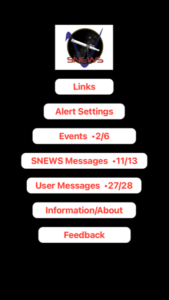If you are interested in being notified about the occurrence of a neutrino burst from SNEWS, please sign up for our alert list. Currently this list is for alerts from the original SNEWS project operating for a couple decades now (no exploding stars in the Milky Way in that time). A new alert list for SNEWS2.0 will go live soon, as well as a list for “firedrill” test campaigns.
SNEWS Alert App
Another way to get a SNEWS alert is via the SNEWS App. This subscribes to the SNEWS alerts published to GCN, and will let you know via your phone. Available only on Apple devices at the moment, an Android app is in the works. This is a cousin of the author’s Gravitational Wave alert app.
Note that weekly automated test messages will be the only traffic till Mother Nature blows up a star somewhere in the Milky Way for us: but, you’ll be ready for that once-in-a-century event!
Like the mailing list above, this gets you original SNEWS network alerts. Once SNEWS2.0 is operational, it will also publish via GCN, making it easy for this app to relay SNEWS2.0 information too.
Amateur Astronomers: We Need Your Help!
If you consider yourself an amateur astronomer, SNEWS may be your chance to make a significant contribution to science. By acting on a SNEWS alert you may be the first to pinpoint a rare Galactic supernova and make early observations!
In the event of a supernova, neutrino detectors may yield limited information about where the supernova source is. In the best case, it may be a few degrees; in the worst case there could be no pointing information at all. Therefore amateurs, with their wide viewing capabilities, may well be the first to find the supernova and point more powerful telescopes to the event. Very early data taken by amateurs themselves may be of prime importance, too. Because Galactic supernovae are so rare (a few per century), it will be especially crucial to see the very early turn-on of the light. The time between the neutrino burst warning and the first visible light could be minutes, hours or days, depending on the nature of the stellar envelope and the amount of obscuration.
Time is of the essence. If you receive a SNEWS alert, act on it swiftly!

